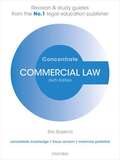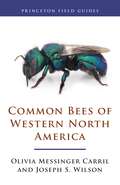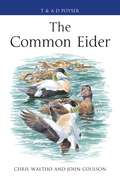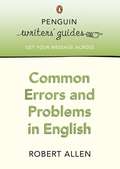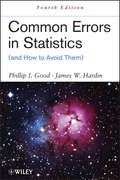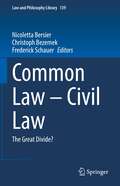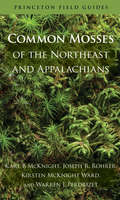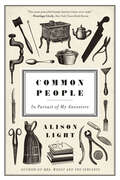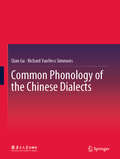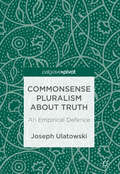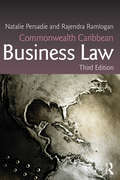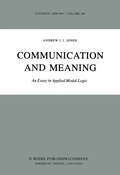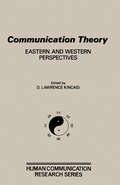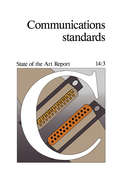- Table View
- List View
Common Bees of Western North America (Princeton Field Guides #124)
by Olivia Messinger Carril Joseph S. WilsonA portable, full-color photographic guide to the most commonly seen bees in the western United States and CanadaBees play a vitally important role in the pollination of native plants and agricultural crops around the globe. These stunningly beautiful insects come in a wide range of sizes, shapes, and colors. There are more than 3,000 species in western North America, and identifying them is a challenging task even for taxonomists. Common Bees of Western North America is the first species-level photographic field guide to the most commonly seen bees in the western United States and Canada, focusing on those that are found in urban environments, specialize on unique plants, or are especially distinctive in appearance. This book walks you through the process of bee identification using breathtaking high-resolution color photos that highlight the key characteristics of each species, making identification easier. Full of essential facts about the natural history of these magnificent creatures, this is a must-have field guide for naturalists and backyard gardeners alike.Covers more than 200 speciesFeatures more than 1,100 stunning close-up color photosShows multiple images of each species, with arrows indicating key featuresIncludes a range map for every speciesProvides silhouette images depicting the actual size of each speciesDescribes key identification features, size, phenology, floral preference, nesting, and related speciesContains a taxonomic key to the bee genera of the region
Common Concern of Humankind im Völkerrecht (Beiträge zum ausländischen öffentlichen Recht und Völkerrecht #289)
by Oliver StrankDieses Buch untersucht die philosophischen Grundlagen und die geschichtliche Entwicklung des common concern of humankind-Begriffs und seine Rechtswirkungen im Völkerrecht. Hierbei wird das Prinzip in den Bestand des Umweltvölkerrechts eingeordnet und sein Verhältnis zum Grundsatz der Staatensouveränität untersucht. Außerdem wird das common concern-Prinzip vom common heritage-Prinzip abgegrenzt und völkerrechtstheoretisch dargelegt, welche Wirkung es als Prinzip innerhalb und außerhalb der von ihm erfassten Regime entfaltet. Der Autor begründet, dass mit der Verankerung des common concern of humankind-Prinzips in der Klimarahmenkonvention und im Pariser Abkommen sowie in der Biodiversitätskonvention die dort enthaltenen Umweltschutzpflichten zu solchen gegenüber der Staatengemeinschaft als Ganzes geworden sind, sodass sich alle Vertragsstaaten - unabhängig von einer eigenen Betroffenheit - gegenüber allen anderen Vertragsstaaten auf ihre Erfüllung berufen können und eine Klagebefugnis vor dem Internationalen Gerichtshof haben.
The Common Eider
by Chris Waltho John CoulsonA common sight around the more northerly shores of the British Isles, the Common Eider is the largest duck in the northern hemisphere. The eider is particularly well adapted to cold-water environments; the insulating properties of eider down are iconic. The species is taxonomically interesting, with a range of well-marked subspecies reflecting the patterns of ice coverage during ancient glaciations, and these ducks have also provided the focus for a number of important behavioural studies, especially on feeding ecology and energy budgets.Eiders have a long association with humans, and have deep cultural significance in many societies. However, modern lifestyles are exposing these ducks to a wide range of new pressures.This monograph provides a comprehensive portrait of the Common Eider; authors Chris Waltho and John Coulson bring together an extensive and diverse international literature, with sections on taxonomy, habitats, breeding biology, population dynamics, diet and foraging, dispersal and migration, and conservation.
The Common Eider (Poyser Monographs #35)
by Chris Waltho John CoulsonA common sight around the more northerly shores of the British Isles, the Common Eider is the largest duck in the northern hemisphere. The eider is particularly well adapted to cold-water environments; the insulating properties of eider down are iconic. The species is taxonomically interesting, with a range of well-marked subspecies reflecting the patterns of ice coverage during ancient glaciations, and these ducks have also provided the focus for a number of important behavioural studies, especially on feeding ecology and energy budgets.Eiders have a long association with humans, and have deep cultural significance in many societies. However, modern lifestyles are exposing these ducks to a wide range of new pressures.This monograph provides a comprehensive portrait of the Common Eider; authors Chris Waltho and John Coulson bring together an extensive and diverse international literature, with sections on taxonomy, habitats, breeding biology, population dynamics, diet and foraging, dispersal and migration, and conservation.
Common Errors and Problems in English
by Robert AllenThe Penguin Writers' Guides series provide authoritative, succinct and easy-to-follow guidance on specific aspects of written English. Whether you need to brush up your skills or get to gris with something for the first time, these invaluable Guides will help you find the best way to get your message across clearly and effectively.Common Errors in English is a thorough A-Z checklist of the mistakes that often crop up in all aspects of written English. It gives ready and authoritative guidance on today's usage difficulties, being up-to-date with all the latest controversies, pitfalls and oddities of our language. Written in a lively style, with plenty of interest and humour, Common Errors shouldn't be far from the fingertips of anyone who does any kind of writing.
Common Errors in Statistics (and How to Avoid Them)
by Phillip I. Good James W. HardinPraise for Common Errors in Statistics (and How to Avoid Them) "A very engaging and valuable book for all who use statistics in any setting." —CHOICE "Addresses popular mistakes often made in data collection and provides an indispensable guide to accurate statistical analysis and reporting. The authors' emphasis on careful practice, combined with a focus on the development of solutions, reveals the true value of statistics when applied correctly in any area of research." —MAA Reviews Common Errors in Statistics (and How to Avoid Them), Fourth Edition provides a mathematically rigorous, yet readily accessible foundation in statistics for experienced readers as well as students learning to design and complete experiments, surveys, and clinical trials. Providing a consistent level of coherency throughout, the highly readable Fourth Edition focuses on debunking popular myths, analyzing common mistakes, and instructing readers on how to choose the appropriate statistical technique to address their specific task. The authors begin with an introduction to the main sources of error and provide techniques for avoiding them. Subsequent chapters outline key methods and practices for accurate analysis, reporting, and model building. The Fourth Edition features newly added topics, including: Baseline data Detecting fraud Linear regression versus linear behavior Case control studies Minimum reporting requirements Non-random samples The book concludes with a glossary that outlines key terms, and an extensive bibliography with several hundred citations directing readers to resources for further study. Presented in an easy-to-follow style, Common Errors in Statistics, Fourth Edition is an excellent book for students and professionals in industry, government, medicine, and the social sciences.
Common Errors in Statistics (and How to Avoid Them): Introduction To Statistics Through Resampling Methods And Microsoft Office Excel
by Phillip I. Good James W. HardinPraise for Common Errors in Statistics (and How to Avoid Them) "A very engaging and valuable book for all who use statistics in any setting." —CHOICE "Addresses popular mistakes often made in data collection and provides an indispensable guide to accurate statistical analysis and reporting. The authors' emphasis on careful practice, combined with a focus on the development of solutions, reveals the true value of statistics when applied correctly in any area of research." —MAA Reviews Common Errors in Statistics (and How to Avoid Them), Fourth Edition provides a mathematically rigorous, yet readily accessible foundation in statistics for experienced readers as well as students learning to design and complete experiments, surveys, and clinical trials. Providing a consistent level of coherency throughout, the highly readable Fourth Edition focuses on debunking popular myths, analyzing common mistakes, and instructing readers on how to choose the appropriate statistical technique to address their specific task. The authors begin with an introduction to the main sources of error and provide techniques for avoiding them. Subsequent chapters outline key methods and practices for accurate analysis, reporting, and model building. The Fourth Edition features newly added topics, including: Baseline data Detecting fraud Linear regression versus linear behavior Case control studies Minimum reporting requirements Non-random samples The book concludes with a glossary that outlines key terms, and an extensive bibliography with several hundred citations directing readers to resources for further study. Presented in an easy-to-follow style, Common Errors in Statistics, Fourth Edition is an excellent book for students and professionals in industry, government, medicine, and the social sciences.
Common Law – Civil Law: The Great Divide? (Law and Philosophy Library #139)
by Nicoletta Bersier Christoph Bezemek Frederick SchauerThis book offers an in-depth analysis of the differences between common law and civil law systems from various theoretical perspectives. Written by a global network of experts, it explores the topic against the background of a variety of legal traditions.Common law and civil law are typically presented as antagonistic players on a field claimed by diverse legal systems: the former being based on precedent set by judges in deciding cases before them; the latter being founded on a set of rules intended to govern the decisions of those applying them. Perceived in this manner, common law and civil law differ in terms of the (main) source(s) of law; who is to create them; who is (merely) to draw from them; and whether the law itself is pure each step of the way, or whether the law’s purity may be tarnished when confronted with a set of contingent facts. These differences have deep roots in (legal) history – roots that allow us to trace them back to distinct traditions. Nevertheless, it is questionable whether the divide thus depicted is as great as it may seem: international and supranational legal systems unconcerned by national peculiarities appear to level the playing field. A normative understanding of constitutions seems to grant ever-greater authority to High Court decisions based on thinly worded maxims in countries that adhere to the civil law tradition. The challenges contemporary regulation faces call for ever-more detailed statutes governing the decisions of judges in the common law tradition. These and similar observations demand a structural reassessment of the role of judges, the power of precedent, the limits of legislation and other features often thought to be so different in common and civil law systems. The book addresses this reassessment.
Common Mosses of the Northeast and Appalachians (PDF)
by Karl B Mcknight Joseph R. Rohrer Kirsten Mcknight Ward Warren J. PerdrizetThis is the first book to help general readers recognize 200 common mosses of the Northeast and the Appalachian Mountains. With just this field guide, a hand lens, and a spray bottle--no microscopes necessary--readers will be able to identify and name many of the common species of mosses growing in the region's backyards, parks, forests, wetlands, and mountains. At the heart of this guide is an innovative, color-tabbed system that helps readers pick out small groups of similar species. Illustrated identification keys, colorful habitat and leaf photos, more than 600 detailed line drawings, and written descriptions help differentiate the species. This accessible book allows all nature enthusiasts to make accurate identifications and gain access to the enchanting world of mosses. 200 species included More than 600 detailed line drawings More than 400 color photographs Innovative color-tabbed system for species identification Illustrated species identification keys Helpful tips for moss collecting
Common People: In Pursuit of My Ancestors
by Alison Light“Family history begins with missing persons,” Alison Light writes in Common People. We wonder about those we’ve lost, and those we never knew, about the long skein that led to us, and to here, and to now. So we start exploring. Most of us, however, give up a few generations back. We run into a gap, get embarrassed by a ne’er-do-well, or simply find our ancestors are less glamorous than we’d hoped. That didn’t stop Alison Light: in the last weeks of her father’s life, she embarked on an attempt to trace the history of her family as far back as she could reasonably go. The result is a clear-eyed, fascinating, frequently moving account of the lives of everyday people, of the tough decisions and hard work, the good luck and bad breaks, that chart the course of a life. Light’s forebears—servants, sailors, farm workers—were among the poorest, traveling the country looking for work; they left few lasting marks on the world. But through her painstaking work in archives, and her ability to make the people and struggles of the past come alive, Light reminds us that “every life, even glimpsed through the chinks of the census, has its surprises and secrets.” What she did for the servants of Bloomsbury in her celebrated Mrs. Woolf and the Servants Light does here for her own ancestors, and, by extension, everyone’s: draws their experiences from the shadows of the past and helps us understand their lives, estranged from us by time yet inextricably interwoven with our own. Family history, in her hands, becomes a new kind of public history.
Common People: In Pursuit of My Ancestors
by Alison Light“Family history begins with missing persons,” Alison Light writes in Common People. We wonder about those we’ve lost, and those we never knew, about the long skein that led to us, and to here, and to now. So we start exploring. Most of us, however, give up a few generations back. We run into a gap, get embarrassed by a ne’er-do-well, or simply find our ancestors are less glamorous than we’d hoped. That didn’t stop Alison Light: in the last weeks of her father’s life, she embarked on an attempt to trace the history of her family as far back as she could reasonably go. The result is a clear-eyed, fascinating, frequently moving account of the lives of everyday people, of the tough decisions and hard work, the good luck and bad breaks, that chart the course of a life. Light’s forebears—servants, sailors, farm workers—were among the poorest, traveling the country looking for work; they left few lasting marks on the world. But through her painstaking work in archives, and her ability to make the people and struggles of the past come alive, Light reminds us that “every life, even glimpsed through the chinks of the census, has its surprises and secrets.” What she did for the servants of Bloomsbury in her celebrated Mrs. Woolf and the Servants Light does here for her own ancestors, and, by extension, everyone’s: draws their experiences from the shadows of the past and helps us understand their lives, estranged from us by time yet inextricably interwoven with our own. Family history, in her hands, becomes a new kind of public history.
Common People: In Pursuit of My Ancestors
by Alison Light“Family history begins with missing persons,” Alison Light writes in Common People. We wonder about those we’ve lost, and those we never knew, about the long skein that led to us, and to here, and to now. So we start exploring. Most of us, however, give up a few generations back. We run into a gap, get embarrassed by a ne’er-do-well, or simply find our ancestors are less glamorous than we’d hoped. That didn’t stop Alison Light: in the last weeks of her father’s life, she embarked on an attempt to trace the history of her family as far back as she could reasonably go. The result is a clear-eyed, fascinating, frequently moving account of the lives of everyday people, of the tough decisions and hard work, the good luck and bad breaks, that chart the course of a life. Light’s forebears—servants, sailors, farm workers—were among the poorest, traveling the country looking for work; they left few lasting marks on the world. But through her painstaking work in archives, and her ability to make the people and struggles of the past come alive, Light reminds us that “every life, even glimpsed through the chinks of the census, has its surprises and secrets.” What she did for the servants of Bloomsbury in her celebrated Mrs. Woolf and the Servants Light does here for her own ancestors, and, by extension, everyone’s: draws their experiences from the shadows of the past and helps us understand their lives, estranged from us by time yet inextricably interwoven with our own. Family history, in her hands, becomes a new kind of public history.
Common People: In Pursuit of My Ancestors
by Alison Light“Family history begins with missing persons,” Alison Light writes in Common People. We wonder about those we’ve lost, and those we never knew, about the long skein that led to us, and to here, and to now. So we start exploring. Most of us, however, give up a few generations back. We run into a gap, get embarrassed by a ne’er-do-well, or simply find our ancestors are less glamorous than we’d hoped. That didn’t stop Alison Light: in the last weeks of her father’s life, she embarked on an attempt to trace the history of her family as far back as she could reasonably go. The result is a clear-eyed, fascinating, frequently moving account of the lives of everyday people, of the tough decisions and hard work, the good luck and bad breaks, that chart the course of a life. Light’s forebears—servants, sailors, farm workers—were among the poorest, traveling the country looking for work; they left few lasting marks on the world. But through her painstaking work in archives, and her ability to make the people and struggles of the past come alive, Light reminds us that “every life, even glimpsed through the chinks of the census, has its surprises and secrets.” What she did for the servants of Bloomsbury in her celebrated Mrs. Woolf and the Servants Light does here for her own ancestors, and, by extension, everyone’s: draws their experiences from the shadows of the past and helps us understand their lives, estranged from us by time yet inextricably interwoven with our own. Family history, in her hands, becomes a new kind of public history.
Common People: In Pursuit of My Ancestors
by Alison Light“Family history begins with missing persons,” Alison Light writes in Common People. We wonder about those we’ve lost, and those we never knew, about the long skein that led to us, and to here, and to now. So we start exploring. Most of us, however, give up a few generations back. We run into a gap, get embarrassed by a ne’er-do-well, or simply find our ancestors are less glamorous than we’d hoped. That didn’t stop Alison Light: in the last weeks of her father’s life, she embarked on an attempt to trace the history of her family as far back as she could reasonably go. The result is a clear-eyed, fascinating, frequently moving account of the lives of everyday people, of the tough decisions and hard work, the good luck and bad breaks, that chart the course of a life. Light’s forebears—servants, sailors, farm workers—were among the poorest, traveling the country looking for work; they left few lasting marks on the world. But through her painstaking work in archives, and her ability to make the people and struggles of the past come alive, Light reminds us that “every life, even glimpsed through the chinks of the census, has its surprises and secrets.” What she did for the servants of Bloomsbury in her celebrated Mrs. Woolf and the Servants Light does here for her own ancestors, and, by extension, everyone’s: draws their experiences from the shadows of the past and helps us understand their lives, estranged from us by time yet inextricably interwoven with our own. Family history, in her hands, becomes a new kind of public history.
Common People: In Pursuit of My Ancestors
by Alison Light“Family history begins with missing persons,” Alison Light writes in Common People. We wonder about those we’ve lost, and those we never knew, about the long skein that led to us, and to here, and to now. So we start exploring. Most of us, however, give up a few generations back. We run into a gap, get embarrassed by a ne’er-do-well, or simply find our ancestors are less glamorous than we’d hoped. That didn’t stop Alison Light: in the last weeks of her father’s life, she embarked on an attempt to trace the history of her family as far back as she could reasonably go. The result is a clear-eyed, fascinating, frequently moving account of the lives of everyday people, of the tough decisions and hard work, the good luck and bad breaks, that chart the course of a life. Light’s forebears—servants, sailors, farm workers—were among the poorest, traveling the country looking for work; they left few lasting marks on the world. But through her painstaking work in archives, and her ability to make the people and struggles of the past come alive, Light reminds us that “every life, even glimpsed through the chinks of the census, has its surprises and secrets.” What she did for the servants of Bloomsbury in her celebrated Mrs. Woolf and the Servants Light does here for her own ancestors, and, by extension, everyone’s: draws their experiences from the shadows of the past and helps us understand their lives, estranged from us by time yet inextricably interwoven with our own. Family history, in her hands, becomes a new kind of public history.
Common Phonology of the Chinese Dialects
by Qian Gu Richard VanNess SimmonsThis book presents a comparative reconstruction of the common phonology of the Chinese dialects using representative data from living dialects. The resulting phonology includes all categories and phonological distinctions that are represented in the dialect data. It departs from the tradition of using philological sources and non-Chinese borrowings as the basis for a reconstructed system. Based on a strict comparative methodology, the phonology presented encapsulates the shared phonology of the dialects and reflects the real-world distinctions and categories found in the living dialects. For example, the initials preserve the tripartite division that includes voiced obstruents seen in Wú dialects; the finals are comparatively drawn based on the collective dialect data; and the syllable codas preserve the three-way contrasts of consonant stop endings seen in the Cantonese dialects. The data presented allows readers to observe the basis for all of the distinction and categories included in the common phonology and the relationship of that phonology to all of the dialects, and as a result to identify the dialects’ disparate developments and evolution. The English translation also includes innovative elements that render it even more useful for researchers than the Chinese original. The book is primarily intended for scholars and researchers investigating the Chinese dialects and their relationships, and the history of Chinese. It is also useful for scholars of Chinese history and literature who need a handy resource providing essential information on the historical phonology of Chinese.
Commonsense Pluralism about Truth: An Empirical Defence
by Joseph UlatowskiTruth is a pervasive feature of ordinary language, deserving of systematic study, and few theorists of truth have endeavoured to chronicle the tousled conceptual terrain forming the non-philosopher’s ordinary view. In this book, the author recasts the philosophical treatment of truth in light of historical and recent work in experimental philosophy. He argues that the commonsense view of truth is deeply fragmented along two axes, across different linguistic discourses and among different demographics, termed in the book as endoxic alethic pluralism. To defend this view, four conclusions must be reached: (1) endoxic alethic pluralism should be compatible with how the everyday person uses truth, (2) the common conception of truth should be derivable from empirical data, (3) this descriptive metaphysical project is one aspect of a normative theory of truth, and (4) endoxic alethic pluralism is at least partially immune to challenges facing the ecological method in experimental philosophy and alethic pluralism.
Commonsense Pluralism about Truth: An Empirical Defence
by Joseph UlatowskiTruth is a pervasive feature of ordinary language, deserving of systematic study, and few theorists of truth have endeavoured to chronicle the tousled conceptual terrain forming the non-philosopher’s ordinary view. In this book, the author recasts the philosophical treatment of truth in light of historical and recent work in experimental philosophy. He argues that the commonsense view of truth is deeply fragmented along two axes, across different linguistic discourses and among different demographics, termed in the book as endoxic alethic pluralism. To defend this view, four conclusions must be reached: (1) endoxic alethic pluralism should be compatible with how the everyday person uses truth, (2) the common conception of truth should be derivable from empirical data, (3) this descriptive metaphysical project is one aspect of a normative theory of truth, and (4) endoxic alethic pluralism is at least partially immune to challenges facing the ecological method in experimental philosophy and alethic pluralism.
Commonwealth Caribbean Business Law (Commonwealth Caribbean Law)
by Natalie Persadie Rajendra RamloganNow in its third edition, Commonwealth Caribbean Business Law continues to break away from the traditional English approach of treating business law primarily as the law of contract and agency. Taking a panoramic view, it explores the foundation of various legal systems before examining areas of legal liability that affect business activities. These include areas such as contract law, tort law, criminal law, agency and internet law which present significant challenges confronting the business sector. The book primarily targets the development of business law principles in several Caribbean Commonwealth jurisdictions but, where appropriate, also embraces the jurisprudence of other Commonwealth nations, such as the United Kingdom, Canada and Australia. It also explores the United States as a non-Commonwealth jurisdiction, given the increasing importance in the Caribbean of judicial pronouncements relating to internet law from this territory. Using excerpts from key judgments, the book allows students, particularly those with a non-legal background, to understand key legal principles for business as presented by the judiciary and draws parallels between legal theory and business practice.
Commonwealth Caribbean Business Law (Commonwealth Caribbean Law)
by Natalie Persadie Rajendra RamloganNow in its third edition, Commonwealth Caribbean Business Law continues to break away from the traditional English approach of treating business law primarily as the law of contract and agency. Taking a panoramic view, it explores the foundation of various legal systems before examining areas of legal liability that affect business activities. These include areas such as contract law, tort law, criminal law, agency and internet law which present significant challenges confronting the business sector. The book primarily targets the development of business law principles in several Caribbean Commonwealth jurisdictions but, where appropriate, also embraces the jurisprudence of other Commonwealth nations, such as the United Kingdom, Canada and Australia. It also explores the United States as a non-Commonwealth jurisdiction, given the increasing importance in the Caribbean of judicial pronouncements relating to internet law from this territory. Using excerpts from key judgments, the book allows students, particularly those with a non-legal background, to understand key legal principles for business as presented by the judiciary and draws parallels between legal theory and business practice.
Communicating Partners: 30 Years of Building Responsive Relationships with Late Talking Children including Autism, Asperger's Syndrome (ASD), Down Syndrome, and Typical Devel
by James D. MacDonaldThe program focuses on five key stages of communication development - interactive play, nonverbal communication, social language, conversation, and civil behaviour - and five life-long responsive strategies to use every day to build relationships within the child's own world.
Communication and Meaning: An Essay in Applied Modal Logic (Synthese Library #168)
by A.J JonesThis essay contains material which will hopefully be of interest not only to philosophers, but also to those social scientists whose research concerns the analysis of communication, verbal or non-verbal. Although most of the topics taken up here are central to issues in the philosophy of language, they are, in my opinion, indistinguishable from topics in descriptive social psychology. The essay aims to provide a conceptual framework within which various key aspects of communication can be described, and it presents a formal language, using techniques from modern modal logic, in which such descriptions can themselves be formulated. It is my hope that this framework, or parts of it, might also turn out to be of value in future empirical work. There are, therefore, essentially two sides to this essay: the development of a framework of concepts, and the construction of a formal language rich enough to express the elements of which that framework is composed. The first of these two takes its point of departure in the statement quoted from Lewis (1972) on the page preceding this introduction. The distinction drawn there by Lewis is accepted as a working hypothesis, and in one sense this essay may be seen as an attempt to explore some of the consequences of that hypothesis.
Communication Theory: Eastern and Western Perspectives
by D. Lawrence KincaidCommunication Theory: Eastern and Western Perspectives focuses on the processes, methodologies, principles, and approaches involved in communication theory. The selection first elaborates on Asian perspectives on communication theory; Chinese philosophy and contemporary human communication theory; communication in Chinese narrative; and contemporary Chinese philosophy and political communication. Discussions focus on the structure and function of China's political communication system; philosophical principles of Chinese communism; embodiment of reason in experience; and dialectic completion of relative polarities. The text then examines Korean philosophy and communication, practice of Uye-Ri in interpersonal relationships, and the teachings of Yi Yulgok. The publication examines the double-swing model of intercultural communication between the East and the West; interpersonal cognition, message goals, and organization of communication; and the convergence theory of communication, self-organization, and cultural evolution. The book also ponders on the practice of Antyodaya in agricultural extension communication in India and communication within Japanese business organizations. The selection is a valuable reference for researchers interested in the Eastern and Western perspectives of communication theory.
Communications Standards: State of the Art Report 14:3
by A. V. StokesCommunications Standards deals with the standardization of computer communication networks. This book examines the types of local area networks (LANs) that have been developed and looks at some of the relevant protocols in more detail. The work of Project 802 is briefly discussed, along with a protocol which has developed from one of the LAN standards and is now a de facto standard in one particular area, namely the Manufacturing Automation Protocol (MAP). Factors that affect the usage of networks, such as network management and security, are also considered. This book is divided into three sections and begins with an overview of various aspects of communications standards, paying particular attention to the ISO Open Systems Interconnection (OSI) Network Layer. Conformance testing of protocols and the use of computers in the manufacturing industry are considered. The following chapters focus on the OSI Data Link Layer, Physical Layer, and Session Layer; management issues in OSI; the ISO File Transfer, Access and Management (FTAM) protocol; and the different environments in which OSI and IBM's Systems Network Architecture (SNA) are defined. Message-handling protocols, the CCITT Recommendation X.25, and high-level protocols on Ethernet are also described. This monograph will be of interest to professionals in the field of computer science.
